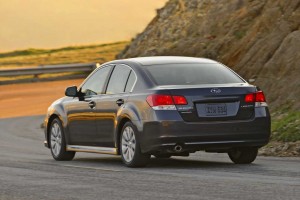
Leading the way: Subaru was one of only three brands to post a sales gain in 2009 and will close the year with record volume.
While December’s numbers may hold the faint glimmering of hope, it will be difficult to put much of a positive spin on dismal 2009 – unless you’re Subaru of America (SoA), that is. When the year’s final numbers are reported, this week, the U.S. market will show a decline of 24%, to the lowest level of sales since the deep recession of the early 1980s. But despite the doom-and-gloom of the American economy, Subaru somehow pulled off a 14% increase in sales for the year.
The Japanese maker, long little more than a niche marketer, jumped from 19th among all automotive brands operating in the U.S., surging past Volkswagen of America – whose parent will end ’09 as the world’s largest automaker – and coming within a hairsbreadth of Chrysler’s Jeep division.
Subaru was one of only three brands to post a sales gain in the U.S. in 2009 – Korea’s Kia was up 8%, while its sibling, Hyundai, gained 6%. And the Japanese maker did it without relying on the budget-busting cash-back offers that propped up its rivals. While the automaker won’t provide precise details, industry-watchers estimate SoA spent an average of just $1,800 a vehicle in rebates and other givebacks, compared with an industry average of $2,700, and more than $5,000 for some brands, such as General Motors.
But the maker has been cutting prices since senior U.S. managers took the critical step, in 2006, in focusing on affordability, rather than following the strategy originally dictated back in Japan of moving up-market, with products like the Tribeca. Instead, SoA took dead aim at the mainstream, with models like the Outback and Imprezza, emphasizing value, quality and safety.
For years, Subaru marketers seemed to relish the idea of positioning their brand as a quirky alternative, something that did work well with groups that stood outside the mainstream, from gays to nurses. And the brand’s emphasis on all-wheel-drive helped it sell well in snowy climes like Colorado and New England.
The trick has been to maintain that niche appeal while also gaining traction in more mainstream markets, says executive Mike McHale. The company’s latest advertising efforts may be a bit more traditional, but Subaru hasn’t gone entirely middle-of-the-road, as its “Share the Love” campaign underscores. The promotion, first launched in late 2008 and then rolled out again just before the 2009 holiday season, offers to provide $250 to charity for each new Subaru the company sells.
“We don’t miss the $250 but our customers will remember they gave money to the ASPCA” or one of four other charities, says McHale.
Of course, product is always key in a competitive market, and Subaru has been aggressively updating its line-up. There was a new version of the Legacy, for example, as well as the Outback. Sales of the latter model tripled, year-over-year, with the debut of the new model.
But backed up by an expanded dealer network stretching into Sunbelt states where the brand had traditionally been weak, Subaru started pitching all-wheel-drive as a safety and performance feature that works on dry roads as well as icy ones. The company’s biggest growth, notes McHale, came in warmer climes. Atlanta, for example, saw a 27% gain for 2009.
Numbers like that aren’t lost on dealers, who are prone to putting both dollars and human resources behind the brands that deliver them the best returns. Behind the scenes, Subaru worked to ensure dealer performance, and the company estimates 90% of them finished the year in the black – at a time when a record number of automotive retailers are going out of business.
Can Subaru maintain the momentum in 2010? That will be the real challenge for the brand, analysts warn, especially with no major launches coming. The maker is working up a hybrid, but that won’t hit market until 2012. And it’s still not clear if and when a new sports car, developed in partnership with Toyota, will make it to the States.
While final figures aren’t yet available, it’s likely Subaru will wrap up 2009 with volumes of around 214,000, which would surge past the previous all-time record of 200,703, set in 2006. As for 2010, the maker is playing it cautious. McHale cautions that Subaru is “not set up” to reach sales levels of 300,000. “If we can sell 10% more next year,” he adds, “we’ll be delighted.”


don’t forget the WRX and Grand Turismo